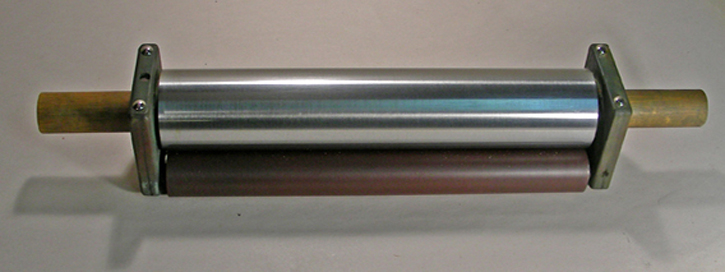

 |
 |
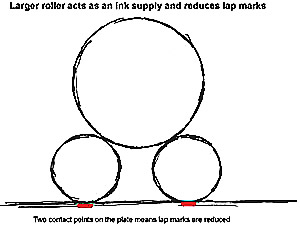 |
A Revolutionary system that allows printers to easily print those colors that tend to make editioning more difficult than it should be. Designed for hand printing waterless lithographic plates, it also works just as well in traditional gum etch lithography when using colored inks. Printers may have noticed that small diameter brayers would pickup loose ink off the plate, but the carrying capacity of these would not make editioning efficient. By using the concept of small diameter rollers and a large supply roller, this system can actually hold more ink than the ordinary rubber roller in the print shop. |
You may have tried printing waterless lithography using traditional litho inks and rollers and were disappointed with the results. Tinting of the non-image areas is the biggest problem in this new technology and has to be overcome to allow printmakers the freedom that waterless lithography gives. On big commercial offset presses, the tinting problem is overcome by controlling the temperature of the ink and therefore its viscosity. With common quick-set inks, which turn out to be quite acceptable for hand printed waterless and can be modified with additives, there are ad vantages at times to use a less viscous ink on some images. This can cause tinting when using large diameter rollers as there is not enough “snap” to lift the ink off the nonprinting areas of the plate. |
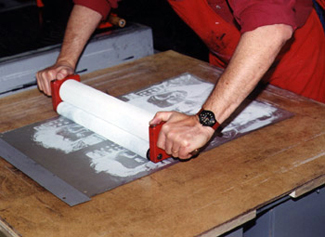 |
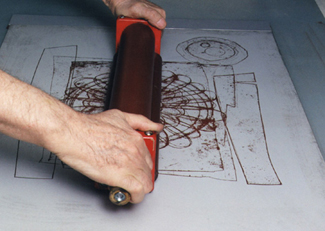 |
Waterless lithography is a new technology that is becoming increasingly important for printmakers in North America. My research has focused on the use of common caulking silicone as the ink rejection layer. To make the process work, I recommend using standard quick-set inks such as Van Son Rubber Base Plus. To increase viscosity and reduce tinting problems, a very small amount of an epoxy hardener alone is added. To get the best detail from a waterless plate, I find that a looser ink picks up the most delicate tints and at the same time prevents ink squash and darkening in the richer areas. It is here that the 3 part roller comes into its own. The many surfaces in the roller tend to even out overlaps and produce a better image. When used with a proper siliconed subplate, the inking area can be kept clean with less likelihood of getting unwanted ink on your prints. |
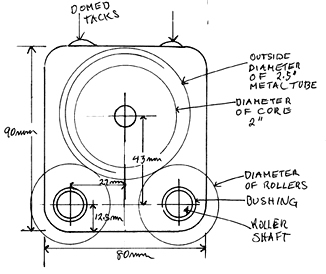 |
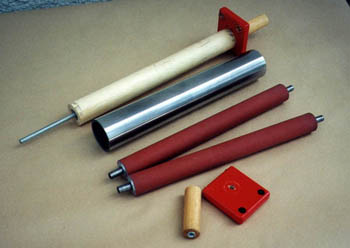 |
Waterless lithography requires a special three part roller to get the best results from the process. This roller greatly reduces tinting, the main printing problem with waterless lithography. Developed over five years and countless prototypes, this rollers brings simplicity and precision to the construction. The rubber rollers are manufactured from the best LHB (HT) Nitrile material available, producing a system that will last for years. The tube roller is constructed from DOM (Drawn Over Mandrel) steel that is worked to tolerances that produces an even layer of ink on the plate. A central wooden core runs through the metal tube roller, giving support for the entire system. It is made from two pieces glued together to prevent warping and roller misalignment. Handles at each end are screwed on a threaded rod to hold the system together. |
 |
The roller consists of two rubber rollers that contact the ink slab and plate. Ink is transferred from the them to the larger steel tube that becomes the third roller in the system. The total circumference of all the rollers in 17.25 inches, which is 37% more ink holding surface than the average 4 inch roller used in most shops. With a 15 inch wide system, large plates can be quickly rolled up and flats can be more even in ink coverage. |
This roller can also be effectively used for traditional lithography as the ink deposits are better because of the multiple rollers. It is especially useful for the hard to print yellow and reds inks. It is being used by a number of printmakers who print in traditional lithography exclusively. Great to use as it will not produce blisters on the hands because the handles do not turn
|
Invented by Nik Semenoff, who in 1990 developed the use of caulking silicone as the basis for his waterless lithography process, the roller has been researched and tested to produce excellent results. Manufacturing tolerances are kept in balance between expensive machining, which results in no better imaging, and loose fitting parts that cost less to produce. |
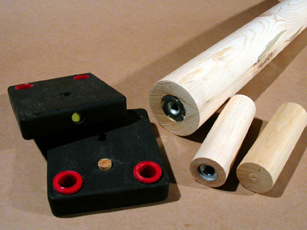 |
| The reason for this unusual design is to help overcome tinting which is a common problem with waterless lithography. Even with the use of quick-set inks, there might be some tinting if the plate was not properly processed, or a particular ink pigment may be the problem. By having a small diameter rollers contact the plate, the amount of lift (which produces snap) for any given speed of rolling, is greater with smaller diameters than with the average litho roller. |
Specifications of roller system: • Rubber rollers are 15 inches long and 1.5 inches in diameter. This roller can also be effectively used for traditional lithography as the ink deposits are better because of the multiple rollers. It is especially useful for the hard to print yellow and reds inks. It is being used by a number of printmakers who print in traditional lithography exclusively. Great to use as it will not produce blisters on the hands because the handles do not turn The roller and box is priced to sell for $650.00 Canadian. Shipping is extra and will depend on the selected carrier. Presently it costs $40 to ship to cities in the US and $20 for Canada. Please indicate your preference of delivery method, otherwise it will be shipped by ground Canada Post and Expedited US Parcel Post into the US.. Include the cost of shipping with your order, but please contact me first so I can get a quote from the shipping agency on the cost of getting the roller to you overseas |
Place order with:
For more information, contact Nik Semenoff: |